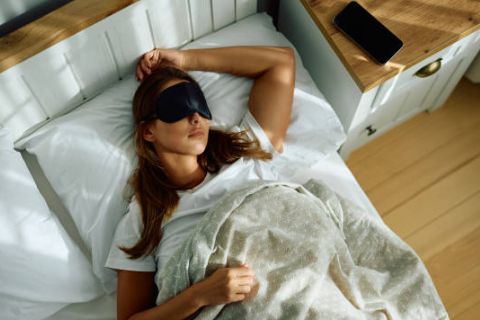The healthiest sleep positions are the ones that help you fall asleep peacefully, stay asleep through the night, and wake up pain-free. If your sleep posture is causing discomfort or pain, it can affect how long it takes you to fall asleep, how long you sleep, and how often you wake up during the night.
Experts generally agree that sleeping on your side or back are the best positions. But sleeping on your stomach or with your upper body elevated can also offer benefits in some cases.

1. Left Side Sleeping
Sleeping on your left side is ideal for people dealing with back pain, neck pain, acid reflux, or sleep apnea. It’s also the recommended position during pregnancy, as it helps relieve pressure on the vena cava and supports blood flow later in pregnancy.
This position helps keep your hips and head aligned, promoting a healthy spinal posture and reducing lower back strain. It can also ease pressure on the neck, which helps reduce neck pain.
Left-side sleeping can reduce pressure on internal organs and keep the airways open, making it easier to breathe. It also helps prevent acid from traveling up the esophagus, reducing heartburn and acid reflux.
2. Right Side Sleeping
Just like the left side, sleeping on your right side helps align the spine and lower back, relieving pressure and pain in the neck and lower back.
This position may be especially good for heart health, and studies suggest it can benefit people with anxiety or depression. Right-side sleeping can also improve airflow for people who snore or have sleep apnea.
Research shows that sleeping on your right side reduces nervous system activity, which may help lower blood pressure and heart rate—especially helpful for people with heart conditions. It might also make you feel more relaxed and reduce the chance of nightmares.
As people age, they tend to sleep more on their right side—possibly as a natural way to protect the heart.
3. Back Sleeping
Sleeping on your back, or the supine position, is a great option for those with back pain, neck pain, or swelling in the legs and feet.
This position keeps your spine in a neutral position, similar to standing up straight, and evenly distributes body weight—reducing pressure points that can cause pain.
However, it may worsen snoring and sleep apnea because gravity can cause the tongue and soft tissues to fall back, blocking airways. Some people also experience lower back pain from a gap between the mattress and their lower back.
If you have swelling (edema) in your legs, elevating them with a pillow or wedge above heart level while lying on your back can help.
4. Sleeping with Upper Body Elevated
If you’re congested, sleeping with your upper body elevated can help improve breathing. Propping yourself up allows better airflow through your nasal passages, easing congestion.
Lying flat when you have a stuffy nose can cause mucus to pool in your sinuses. Using pillows to slightly raise your head and chest can relieve sinus pressure and postnasal drip, both of which can trigger nighttime coughing and discomfort.
5. Stomach Sleeping
Sleeping on your stomach is generally considered the least ideal position. It often causes misalignment in the spine and can worsen back and neck pain.
Studies show that stomach sleepers often experience more pain, wake up more frequently, and have lower-quality sleep. This position puts extra pressure on the spine and provides the least support for the back.
That said, some research suggests that sleeping on your stomach can help open the airway and reduce snoring for people with sleep apnea.

How to Choose the Best Sleep Position for You
Most people sleep in a certain position simply out of habit or comfort. But adjusting your sleep posture could improve your sleep quality and ease certain health conditions. Here are a few things to consider:
-
Pain Points: For neck or back pain, sleeping on your side or back is best. If you have lower or mid-back pain, lying on your back may help. For neck pain, side sleeping is often more comfortable.
-
Breathing Issues: If you snore or have sleep apnea, side sleeping is typically best for keeping your airway open. In some cases, stomach sleeping may also help with breathing.
-
Body Type: People with larger bodies may find back sleeping uncomfortable due to pressure on the hips and abdomen. Sleeping on your side with bent knees and a pillow between your legs can relieve pressure and improve posture.
-
Skin Health: If you’re worried about acne or wrinkles, back sleeping prevents your face from rubbing against the pillow. Side and stomach positions can cause skin stretching and transfer acne-causing bacteria from the pillowcase to your skin.
-
Sleep Quality: Studies show that people who sleep on their right side tend to toss and turn less, which may result in better overall sleep quality.
Additional Tips for Better Sleep
Besides sleep posture, your nightly routine plays a big role in sleep quality. Here are some other ways to improve your sleep:
-
Adjust your pillows: If you sleep on your back and have back pain, place a thin pillow under your knees or lower back. For side sleepers, a small pillow between your knees can improve spinal alignment. If you sleep on your stomach, a thin pillow under your head can help reduce neck strain.
-
Upgrade your mattress: An old or unsupportive mattress can worsen sleep and back pain. A medium-firm, supportive mattress can help with spinal alignment and reduce discomfort.
-
Limit screen time before bed: Try to avoid phones and tablets for at least 30 minutes before sleeping. Blue light from screens reduces melatonin, the hormone that helps you fall asleep.
-
Create a calming sleep environment: Keep your bedroom cool, dark, and quiet. Use blackout curtains, a white noise machine, and set your thermostat between 65–70°F (18–21°C) for optimal sleep comfort.
-
Avoid caffeine and alcohol late in the day: Caffeine within five hours of bedtime can delay sleep. Alcohol disrupts your sleep cycle, reducing the quality of your rest—even if it helps you fall asleep faster.

